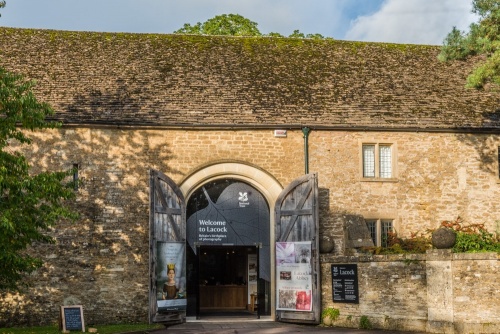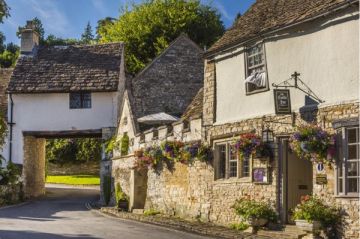
If anyplace can be said to be the birthplace of photography it is Lacock Abbey, the family home of William Henry Fox Talbot. It was here in his Wiltshire home that Fox Talbot developed the calotype process of photography, enabling multiple prints from one negative.
Visitors to Lacock Abbey can see the oriel window that Fox Talbot photographed in what is perhaps the most important photo in history - the one that made all others possible.
At the entrance to the Lacock Abbey grounds stands a Grade II listed 16th-century barn that has been converted into a fascinating museum covering Fox Talbot's life and the birth of photography in general.

The museum opened in 1975 in the former barn, later used as a stable. The museum aims to tell the story of photography through original objects, including Fox Talbot's 'mousetrap' camera. Here you can learn about the chemistry behind Fox Talbot's breakthrough, and his race with Louis Daguerre to become the 'inventor' of photography.
The museum is home to the Fenton Collection, featuring 500 early cameras, optical toys and devices, darkroom equipment and projectors and over 3,000 photographic images from the early days of photography.
The collection was built by James Fenton in the early 20th century and later formed part of the Museum of the Moving Image. When that museum closed its doors in 1999 the Collection went into storage until finding a new home in the Fox Talbot Museum.

William Henry Fox Talbot
This unlikely scientific pioneer was born in Melbury, Dorset on 11 February 1800 to William Davenport Talbot and his wife Lady Elisabeth Fox Strangways, the daughter of the 2nd Earl of Ilchester.
William's father died before he was six months old, leaving the family with enormous debts. They were forced to rent out the family home of Lacock Abbey to a series of tenants. It was not until William was in his 20s that the family was able to move back into Lacock Abbey.
Though very shy, William was a child prodigy, drawn to scientific enquiry. From an early age he studied astronomy, mathematics, physics, optics, and chemistry. He taught himself to read ancient cuneiform writing and became an archaeologist and collector of antiquities.
He was awarded a Fellowship with the Royal Society at the age of just 32, one of the youngest men ever to be so recognised. By that time he had already been a Fellow of the Royal Astronomical Society for a decade. He also served as an MP for Chippenham.
In 1823 the young Fox Talbot met the astronomer John Herschel, who encouraged the young man's interest in light and optics.

In 1832 Fox Talbot married Constance Mundy. The couple honeymooned in Italy, and it was on his honeymoon that Fox Talbot had the germ of an idea that would lead to the invention of the photographic negative. Fox Talbot was trying to sketch the beauty of Lake Como and became frustrated at his inability to render the scene he saw before him.
He later wrote, 'the idea occurred to me; how charming it would be if it were possible to cause these natural images to imprint themselves durably, and remain fixed upon the paper'.
On his return to England Fox Talbot immersed himself in scientific experiments to see if he could bring his idea to life. Over the years 1834-35 he experimented with photographic negatives and the idea of 'fixing' an image using different kinds of salt. He erected box cameras around the grounds of Lacock Abbey to capture the scenery with long exposures. Constance dubbed the crude wooden boxes his 'mousetraps'.
Fox Talbot's most famous early attempt at photography was an image he took of an oriel window in the south range of Lacock Abbey. Visitors to the abbey can see the unaltered window, and see the original photographic negative on display in the museum. This is the oldest photographic negative in the world.

Fox Talbot was rushed into publishing his findings by the knowledge that the Frenchman Louis Daguerre was working on a similar project. Though the 'Daguerreotype' was initially more popular, Fox Talbot developed a 'calotype' process that shortened exposure times to a matter of seconds. The calotype was perhaps the single greatest invention leading to photography as we know it today.
William Henry Fox Talbot continued his scientific research in a wide variety of fields including optics, photomechanical printing and physics. A unit of luminous energy ('the Talbot') is named for him, as is Talbot's Curve in mathematics and Talbot's Law in physics. He died in 1877 and is buried in Lacock cemetery on West Street (not in the churchyard of St Cyriac's Church).

Getting There
The Fox Talbot Museum is at the eastern end of High Street, at the entrance to the Lacock Abbey grounds. There is no dedicated parking, but the main Lacock village visitor car park is a very short stroll away on Hither Way. The car park is operated by the National Trust and there is a charge for non-members.
Entry to the Fox Talbot Museum is included in the fee to enter Lacock Abbey itself. Both are free to National Trust members.
About Fox Talbot Museum, Lacock
Address: High Street,
Lacock,
Wiltshire,
England, SN15 2LG
Attraction Type: Museum
Location: At the eastern end of High Street, at the gates of Lacock Abbey.
Website: Fox Talbot Museum, Lacock
Email: lacockabbey@nationaltrust.org.uk
National Trust - see also:
National Trust memberships (official website link)
Location
map
OS: ST917684
Photo Credit: David Ross and Britain Express
NEARBY HISTORIC ATTRACTIONS
Heritage Rated from 1- 5 (low to exceptional) on historic interest
Lacock Tithe Barn - 0 miles (Historic Building) ![]()
Lacock, St Cyriac's Church - 0.1 miles (Historic Church) ![]()
Lacock Abbey - 0.1 miles (Historic House) ![]()
Corsham Almshouses - 2.9 miles (Historic Building) ![]()
Corsham, St Bartholomew's Church - 3.1 miles (Historic Church) ![]()
Bowood House and Gardens - 3.9 miles (Historic House) ![]()
Sheldon Manor - 4 miles (Historic House) ![]()
Corsham Court - 4.6 miles (Historic House) ![]()
Nearest Holiday Cottages to Fox Talbot Museum, Lacock:
More self catering near Fox Talbot Museum, Lacock




